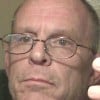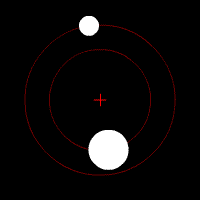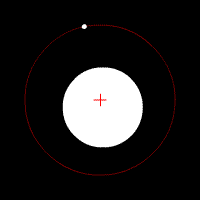How to Detect a Distant Planet
So Far Away You Can't See it with a Telescope
Dear Reader:
I'm sure by now you've heard all about extra-solar planets being discovered. You might also realize that they are finding planets on almost a daily basis and all of them are well outside our solar system; well beyond the dwarf-planet Pluto.
The thing is, if you read these articles carefully, you'll realize that none of these astronomers have actually seen the planets they've discovered; not even with telescopes. So the question is, how do they know that the planets are there? A second likely question is how can they not only find a planet, but tell us what type of planet it is?
Now, if you are an astrophysicist or rocket-scientist, please forgive the liberties I'm about to take here. This article is not for you. I'm attempting to explain, in understandable terms (and leaving out technical details), just how you folks do this.
Cheers,
LiamBean



Detection by Wobble
Since any object orbiting another object causes both to orbit around a common center of gravity. Planets are often discovered simply because the star they are orbiting seems to be moving around in a tight circle. In short that star appears to wobble. The same is true of moons orbiting planets.
The "wobble" can only happen if that star has another body orbiting around it.
The point where the gravity of both objects is centered is called a barycenter. If one object is more massive, such as a sun, the barycenter of both the star and the orbiting planet will have a common center closer to the more massive object. That common center is usually very close to the star or even within the shell of the star itself.
Of course if the planet is more massive, such as a gas giant, the barycenter will be outside the shell of the star and closer to the midpoint of the distance between the star and the planet.
Assuming that this is the case, the images at upper right are pretty good examples of stars being orbited by a variety of planets.
Image one might represent the Earth/Moon orbits. Image two might represent Sun/Mercury. Image three Sun/Mars. Since none of the images at right are labeled as such, these are just loose estimations. But you can see where the "x" is in each image and you can also see that the "x" is never in the center of the more massive body. In other words the more massive body (star) will always wobble.
Finding Wobble by Light
As you may remember light, according to Albert Einstein, always travels at a particular speed in a vacuum. That speed can never increase nor decrease. But the color of the light can be affected by the speed the light reaches your eyes. This is called a Doppler effect.
So, for instance, if the source of light is like that of the sun and that source of light is moving away from the observer, the speed of that light won't change, but it's apparent color will shift toward the red end of the spectrum.
If the light is moving toward the observer that light will be shifted toward the blue end of the spectrum.
In this way the observer can not only tell if the source of light is moving, but whether it is moving toward or away from the observer. Because the red and blue shifting are consistent the observer can also determine (roughly) how fast the object is moving.
But what if the object is blue shifted, then neutral, then red shifted, then neutral. If this pattern is seen as repeating then the object is wobbling.
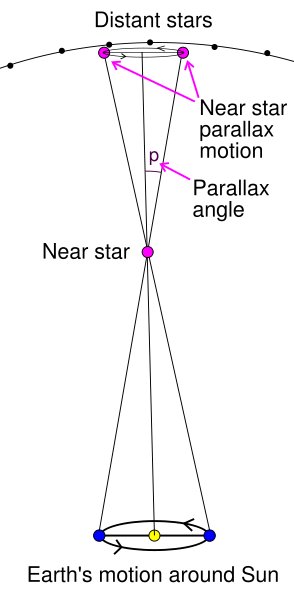
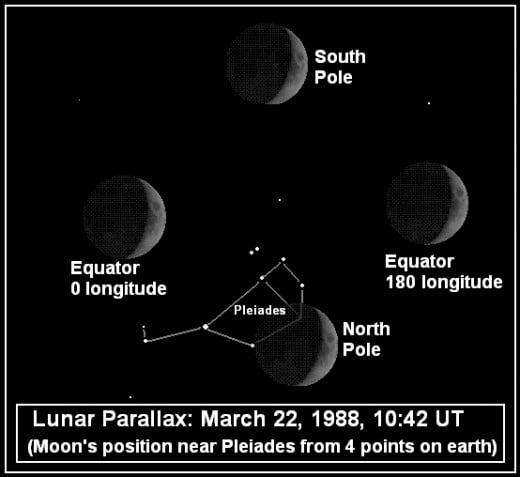

Finding Distance by Parallax
Parallax: "The apparent change in the position of an object due to the change in an observers position."
Even though this term may seem somewhat foreign, a likely conglomeration of parallel and some other term, it's actually from the Greek parallaxis which means "alteration." If you alter your position in relation to a object you can determine its relative size and distance from you. This is the essence of parallax.
If you are an active human you use parallax on a daily basis to determine a number of things about an object. It's distance, size, shape, and even speed.
For example, as you are driving along a highway you can guess the apparent distance to some object (say a billboard) by the side of the roadway simply by moving parallel to it. If you have a rough idea of the size of the object, you can determine its distance by looking at it from two points along the roadway.
In even simpler terms parallax is the result of having two eyes that see objects from slightly different angles. This binocular vision helps us humans determine the shape of an object, it's distance, its size and, over time, its speed.
Determining Distance
As you can see from the image at upper-right the distance and motion of objects in space can be determined by parallax. The distances and angles are not that much different than the driving example above, because they use the same basic principals.
The image upper-right is an example of determining the distance to a star by observing it's apparent position from two positions in Earth's orbit. In this example the object is observed from Earth with a six month delay between observations.
Determining Speed and Wobble
Apparent parallax can also be combined with Doppler shift to determine if an object is moving toward or away from the observer. This combined with parallax will give the observer the speed the object is moving as well as an approximate distance.
Of course if the object displays a repeating Doppler shift i.e. red-shifted, neutral, then blue-shifted, then the object is clearly rotating around another object. If the main object is also wobbling, and it should be, then its pretty certain another body is orbiting around it.

Detection by Transit
This method only works if the solar-system being studied happens to be "edge-on" to the observer. Assuming that the system being studied is perfectly aligned to the observer, any planet passing in front of its sun will cause the observer to witness a slight drop in the amount of light coming from that sun.
To imagine how this works, position yourself such that you are looking at a light (not the sun' it's too bright). Pass your hand between the light and your eyes. Even if you pass a finger between the eyes and light source there will be a slight dimming that takes place. Astronomers, with special instruments that detect the amount of light, can see a dimming of the light from a star. This can often indicate the presence of a planet passing in front of it's sun.
Another problem with this method is that it often leads to false positives. A star may have a variable output that appears to be a planet in transit. Because of this this method often needs to be verified by other means.
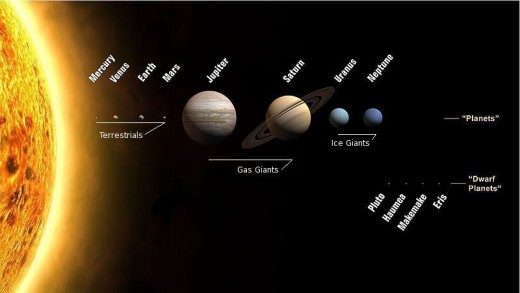
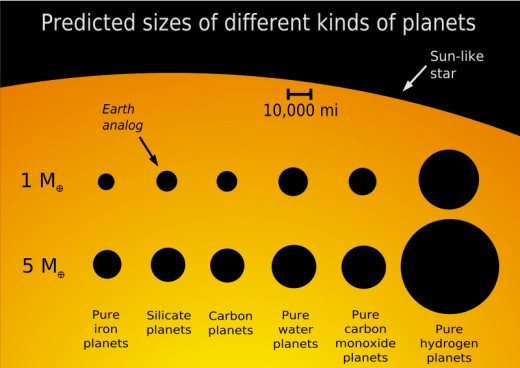
Determining Planet Type
This part of the discovery process is more guess-work and conjecture than the others mentioned above. However, that said, these guesses are still based on directly observable evidence from within our own solar-system.
Viewing the image at right you can see the planets of our solar-system arrayed from closest to the sun to farthest away. The first four planets are called Terrestrial. What this means is that they are mainly rock and/or metal. They are believed to have an iron core, though not always.
The next group is Gas Giant (Jovians). They are considerably larger than Terrestrials and are clearly surrounded by gases. These planets may or may not have a rocky core, but measurements of their orbits and their effect on the sun and nearby planets indicate that if there is a core it's very small with not much mass.
The third planet type in our solar-system is the Ice Giant. These planets are the farthest from the sun and therefore must be the coolest. They are thought to be primarily the liquid states of the gases hydrogen and helium along with water, ammonia and methane ices. Because these planets have a different composition than the Jovians they usually placed in this third "Ice Giant" group.
Rough Comparison
Knowing the general layout of our own solar-system, determining the size of the planet by its effect on the parent star and knowing how fast these planets rotate their parent stars all give planetary scientists a general idea of what type of planet orbits a star. This because our own solar-system features terrestrial, gas giants and ice giants, in that order.
Naturally, a planet that orbits close to its star is unlikely to be a gas giant; it's simply too warm for the gas to remain around the planet. Unless, of course, the planet is exceptionally large and dense. A close in planet is even less likely to be an ice giant. Planets that orbit farther away from their parent star are more likely to be gas giants, and planets that orbit on the outer reaches of a solar-system are more likely to be ice giants.
Of course, what this means is that planetary scientists that make a statements regarding planet type are stating a hypothesis (a guess based on evidence) based somewhat on our own solar-system.
Still, nature has a way of surprising everyone, including those with the best clues and tools.
